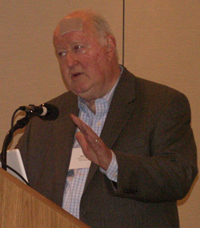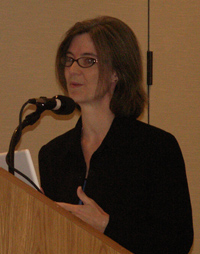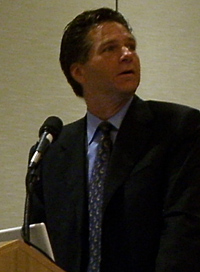Jack Driscoll, Editor-in-Residence, MIT Media Lab
Suzanne McBride, Co-editor, Creating Community Connections
Keith Graham, Associate Professor, University of Montana School of Journalism
“It’s no surprise to anyone in this room that citizen journalism is now a rising force. What is surprising is how long it’s been germinating out there without too much notice.”
 Veteran journalist Jack Driscoll should know: He’s one of the people who has been planting the seeds. Long before anyone had heard of Flickr or Google or Blackberry or wikis or blogs, he created sites that gave voice to the voiceless, with projects like Melrose Mirror in 1997 and the Junior Journal in 1998.
Veteran journalist Jack Driscoll should know: He’s one of the people who has been planting the seeds. Long before anyone had heard of Flickr or Google or Blackberry or wikis or blogs, he created sites that gave voice to the voiceless, with projects like Melrose Mirror in 1997 and the Junior Journal in 1998.
More recently, Driscoll said he wanted to try citizen journalism in a small town: Rye, N.H., a small sea coast village he and many retirees call home. “It’s like starting a bridge club. You put the word out and people come, you have a meeting and soon you are more concerned about the quality of the content than the quantity of people showing up.”Rye Reflections is the result – a monthly journal of major local news stories, features, poetry, opinion.
What kind of major local news stories? A Nor’easter swept through town in May 2007, sending waves crashing over fishing shacks and homes. Rye Reflections set up three slide shows featuring 70 citizen-contributed photographs of the storm.
Editorial decisions at the site are made by consensus and each story is ready by three people before it is published. “Our staff consists of a former airline stewardess, auto dealer, an administrative assistant who worked at CIA, 3 teachers, a principal, a day care supervisor and on and on.” The group meets monthly and publishes the first Thursday of every month.
Regarding the future, Driscoll hopes that Rye Reflections will spawn other similar sites. “Will we make a connection with a daily newspaper in the next town? Who knows? Surely the rise of citizen journalism groups has to raise the question about what kind of synergy there should be with existing daily papers and their Web sites … I leave you to think about that.”
“These are not multiple-source stories. It took me a while to say that’s okay; it’s not libeling anyone. I had to change my thinking about that.“
 Suzanne McBride is the co-founder and co-editor of CreatingCommunityConnections, a hyperlocal Web site launched by the Journalism Department at Columbia College Chicago with start-up funds from J-Lab’s New Voices program. A lifer in the mainstream media, McBride admits her embrace of citizen journalism is somewhat cautious. “I like the gatekeeper function; I’m not comfortable with Wikipedia, I’m not sure I’ll ever be,” she revealed, but “there has to be a better way to cover more local news,” she said.
Suzanne McBride is the co-founder and co-editor of CreatingCommunityConnections, a hyperlocal Web site launched by the Journalism Department at Columbia College Chicago with start-up funds from J-Lab’s New Voices program. A lifer in the mainstream media, McBride admits her embrace of citizen journalism is somewhat cautious. “I like the gatekeeper function; I’m not comfortable with Wikipedia, I’m not sure I’ll ever be,” she revealed, but “there has to be a better way to cover more local news,” she said.
And in Chicago, there’s a lot of news that isn’t covered. “You will see a lot of stories on the Loop, the Gold Coast, for example if there’s a panhandler who robs a shopper.” But not so much coverage of African-American victims of crime in their own communities. CreatingCommunityConnections puts college journalism students on neighborhood beats to uncover some of the stories missed by the mainstream media.
They didn’t want graphophobia to keep people from contributing, so CreatingCommunityConnections also uses old-fashioned voicemail to expand its coverage. People are invited to record a message or a report up to five minutes long. One caller left a highly entertaining review of a hot dog joint and more than 70 people have posted comments in response.
McBride advised, “Be pragmatic about what you are going to get from citizen journalists. You’re going to get a lot of great photos of dogs and cats, but not a lot of people who know they should interview someone on the other side of an issue.”
CreatingCommunityConnections also delves into Chicago politics. McBride said the major dailies have only two reporters covering City Council, while her project is committed to covering the committees where all the action takes place. An investigative reporting class made waves with a series about Chicago aldermen who hire their relatives. They broke the story in the widely-read Beachwood Reporter, an example of how new media sites can increase traffic by partnering with more established press.
Another proud moment: Audio & video interviews with undocumented immigrant Elvira Arellano and her 8-year old son, a U.S citizen. Arellano’s case became a flashpoint for the immigrant rights movement locally and nationally when she sought sanctuary in a Chicago church to avoid deportation and separation from her son.
CreatingCommunityConnections is learning along the way. “Students are idiosyncratic,” said McBride, “They cover what they know and what they’re interested in. So there are still many neighborhoods that are not getting covered … yet.” Still, McBride said that she’s been to some community meetings where people are talking about posts they’ve read on her site. In the world of citizen media, that’s called payment for your story.
“Too many people living in rural America go unnoticed. It’s important to teach journalism students what’s important to small towns.”
 Keith Graham and his colleague Courtney Lowery launched the Rural News Network to serve places off the media’s radar. Their first project was Dutton Country Courier, an online citizen-fueled multimedia site in Lowery’s hometown of Dutton, Mont. (population about 375) which lost its newspaper, the Dutton Dispatch, about 5 years ago.
Keith Graham and his colleague Courtney Lowery launched the Rural News Network to serve places off the media’s radar. Their first project was Dutton Country Courier, an online citizen-fueled multimedia site in Lowery’s hometown of Dutton, Mont. (population about 375) which lost its newspaper, the Dutton Dispatch, about 5 years ago.
Students at the University of Montana School of Journalism helped jump-start the site in the fall of 2006 when they took a three-hour road trip to Dutton and sponsored a town meeting. A whopping 80 people showed up. They surveyed the participants and it turned out that three-quarters have a personal computer at home.
The town librarian said the online newspaper “could be the answer to my prayers” since more folks would come to the library to use computers. Perhaps the local coffee shop could become an internet cafŽ; and the town might even set up a computer room in the senior citizens’ center, after all the average age is over 55.
“How do you educate these people to become journalists?” asked Graham. “We put a community reporter’s notebook on our site. We tell them how to do some stories, go over ethics, how to approach things. If you’re gonna go to city council here are some things to think about.” They are also working on templates to help residents post birth announcements, death announcements, weddings. The town librarian has a regular column and the principal also posts the weekly football standings.
Some of DuttonCC’s big scoops: Reporting on a controversy that erupted when the principal brought a gun to school (he’s also a sheriff’s deputy.) Also, school consolidation is an important focus, since some children have to take a 45-minute bus ride to school each day. On the lighter side: Multimedia coverage of the town’s biggest annual celebration, Dutton Fun Day.
The News Network’s big challenge is that students graduate, so new talent has to be recruited and cultivated and trained over and over again. RNN is set to launch its new site in fall, 2007 in Crow Agency (population 1500). Mainstream media in Montana are trying to figure out how to respond to theses changes in the media landscape.
But back in Dutton, residents are certain the Dutton Country Courier will have long-term positive affects on the community. Graham said the town produces a lot of wheat and meat, but doesn’t have it’s own market. The Mayor told him hopefully, “maybe after this site starts, someone will come and build a grocery store.”
|
Click below to jump to panels: Touching the Community – Outside Traditional Media
Filling in the Gaps – Emerging Competition
Twenty in Thirty – Twenty Good Ideas for Citizen Participation
An Inside Look at the Strategy Behind LoudounExtra.com
AP’s “Now Public” Initiative
Mainstream Media Goes Hyperlocal
Lessons Learned – Backfence.com
|







